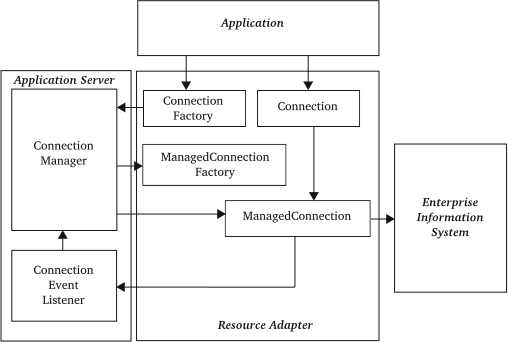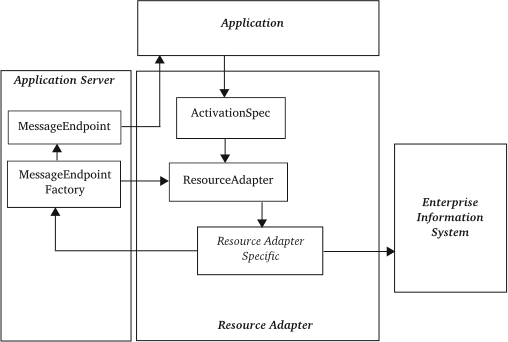Table of Contents
The Java Connector Architecture (JCA) defines a standard architecture for connecting the Java EE platform to heterogeneous Enterprise Information Systems (EIS). Examples of EISs include Enterprise Resource Planning (ERP), mainframe transaction processing (TP), databases and messaging systems.
The connector architecture defines a set of scalable, secure, and transactional mechanisms that enable the integration of EISs with application servers and enterprise applications.
The connector architecture also defines a Common Client Interface (CCI) for EIS access. The CCI defines a client API for interacting with heterogeneous EISs.
The connector architecture enables an EIS vendor to provide a standard resource adapter for its EIS. A resource adapter is a system-level software driver that is used by a Java application to connect to an EIS. The resource adapter plugs into an application server and provides connectivity between the EIS, the application server, and the enterprise application. The resource adapter serves as a protocol adapter that allows any arbitrary EIS communication protocol to be used for connectivity. An application server vendor extends its system once to support the connector architecture and is then assured of seamless connectivity to multiple EISs. Likewise, an EIS vendor provides one standard resource adapter which has the capability to plug in to any application server that supports the connector architecture.
The Java Connector Architecture 1.7 specification adds the following areas:
- Adds an activation name for message endpoints to uniquely identify them
- Deployment annotations for connection factories and administration objects
Note
The deployment annotations are only meant for developer usage, and should not be used in test or production environments.
The IronJacamar standalone and embedded distributions doesn't support these annotations.
The Java Connector Architecture 1.6 specification adds the following major areas:
- Ease of Development: The use of annotations reduces or completely eliminates the need to deal with a deployment descriptor in many cases. The use of annotations also reduces the need to keep the deployment descriptor synchronized with changes to source code.
- Generic work context contract: A generic contract that enables a resource adapter to control the execution context of a Work instance that it has submitted to the application server for execution.
- Security work context: A standard contract that enables a resource adapter to establish security information while submitting a Work instance for execution to a WorkManager and while delivering messages to message endpoints residing in the application server.
- Standalone Container Environment: A defined set of services that makes up a standalone execution environment for resource adapters.
The Java EE Connector Architecture features three different types of resource adapters
- Outbound: The resource adapter allows the application to communicate to the Enterprise Information System (EIS).
- Inbound: The resource adapter allows messages to flow from the Enterprise Information System (EIS) to the application.
- Bi-directional: The resource adapter features both an outbound and an inbound part.
For more information about Java EE Connector Architecture see the specification.
The Java Connector Architecture specification consists of a number of outbound components:

The application uses the
- ConnectionFactory: The connection factory is looked up in Java Naming and Directory Interface (JNDI) and is used to create a connection.
- Connection: The connection contains the Enterprise Information System (EIS) specific operations.
The resource adapter contains
- ManagedConnectionFactory: The managed connection factory creates managed connections.
- ManagedConnection: The managed connection represents a physical connection to the target Enterprise Information System (EIS). The managed connection notifies the application server of events such as connection closed and connection error.
IronJacamar - the application server - contains
- ConnectionManager: The connection manager handles all managed connections in regards to pooling, transaction and security.
- ConnectionEventListener: The connection event listener allows the connection manager to know the status of each managed connection.
The Java Connector Architecture specification consists of a number of inbound components:

The application uses the
- ActivationSpec: The activation specification specifies the different properties that the application is looking for from the resource adapter and hence the Enterprise Information System (EIS). This specification can be hidden from the user by a facade provided by the application server.
The resource adapter contains
- ResourceAdapter: The resource adapter provides the activation point for inbound communication.
- Resource adapter specific: The resource adapter specific code handles communication with the Enterprise Information System (EIS) and deliver messages through the MessageEndpointFactory.
IronJacamar - the application server - contains
- MessageEndpointFactory: The MessageEndpointFactory is registered with the ResourceAdapter instance and creates the MessageEndpoint instances.
- MessageEndpoint: The MessageEndpoint contains the actual message from the Enterprise Information System (EIS) which the application uses. This could for example be a message driven Enterprise JavaBean (EJB/MDB).